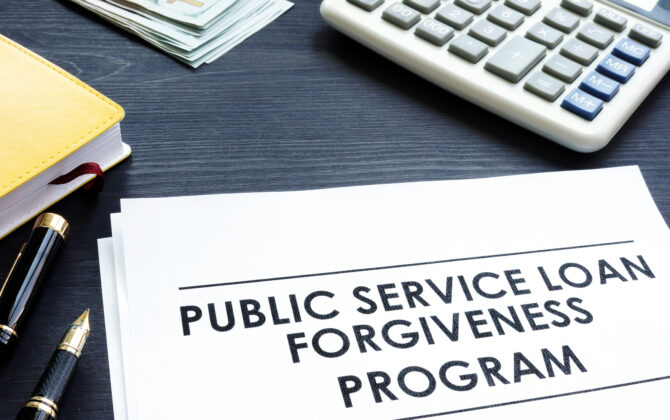What is student loan forgiveness?
Federal student loan forgiveness through one or more government programs could be available to you depending on eligibility factors such as occupation, loan type, and income level. Learn more about eligibility for federal student loan forgiveness programs such as Public Service Loan Forgiveness (PSLF) here and Income-Driven Repayment (IDR) here.
Types of student loan forgiveness & how to apply
If you think you could qualify for federal student loan forgiveness, start by contacting your loan servicer to see what types of federal student loans you have and if you need to take steps to consolidate them. You should also organize the information you’ll need for the application process:
- Your verified Federal Student Aid (FSA) ID – this is the account username and password that allows students (and parents) to identify themselves electronically to access US Department of Education systems
- Your financial information
- Your spouse’s information (if applicable)
Learn more about how to get student loan forgiveness here and read on to understand how to apply for different repayment and forgiveness programs.
Income-Driven Repayment forgiveness
If you’re having difficulty making your monthly student loan payments under the 10-year Standard Repayment Plan, then Income-driven Repayment (IDR) is something you could explore as a federal borrower. The IDR program consists of multiple plans that provide federal borrowers with options other than forbearance:
IDR Comparison Chart
| Applications for IDR plans and loan consolidation are available on http://studentaid.gov. You can also submit a PDF application to your loan servicer by uploading it to your servicer’s website or mailing it to them. Expect a delay in processing times. | |||
| Plan | Monthly Payments | Repayment Period | Status |
| Income-Based Repayment (IBR) |
|
20-25 years, depending on when you become a new borrower | Accepting new enrollments. |
| Income-Contingent Repayment (ICR) |
The lesser of the following:
|
25 years | Accepting new enrollments. |
| Pay as You Earn (PAYE) |
|
20 years | Accepting new enrollments. |
IDR plans use various formulas to calculate repayment structures based on your adjusted gross income and family size, and also provides a path to eventual forgiveness. As a federal student loan borrower, you’re likely to qualify for more than one type of IDR plan. For help understanding which IDR plan could be right for you based on your unique financial profile, schedule a free call with one of our student loan specialists, and read on to learn more about how to apply.
How to Apply
To apply for IDR, follow these steps:
For guidance through the application process and help with compliance requirements once you’re enrolled in IDR, contact our student loan specialists here. We can help you track progress on your application and keep you current on the latest requirements for different forgiveness programs.
Public Service Loan Forgiveness (PSLF)
PSLF is a special federal student loan forgiveness program available to borrowers who work in government or nonprofit organizations. To be eligible for PSLF, you must:
- be employed by a qualifying nonprofit OR a US government organization at any level (federal, state, local, or tribal) – including US military service.
- work full-time for that agency or organization
- have Federal Direct Loans (or consolidate other federal student loans into a Direct Loan)
- be enrolled in an eligible repayment plan (typically an IDR plan)
- make 120 qualifying payments
PSLF is a notoriously complex program with frequently changing rules and requirements. For guidance through the PSLF application process and help staying up-to-date with the latest rules, contact our student loan specialist team.
How to Apply
Before you apply for PSLF, first find out if you qualify for the program. You can use this guide to understand if you have qualifying employment, or use the employer search tool on studentaid.gov to see if your current and past employers are on the eligible list. Given that PSLF requires enrollment in one of the four IDR plans, you’ll need to follow the steps outlined in the timeline above.
- Gather documentation – You’ll need personal ID, and your spouse’s information (if applicable)
- Sign in – Using your FSA username and password, sign in to your account on https://studentaid.gov/.
- Complete IDR application – Answer questions about employment, family size, marital status, and income. The application must be completed in a single session.
- Receive enrollment confirmation – Typically, IDR application processing should take less than two weeks, but it could be longer.
- Recertify annually – You will need to complete and submit the Public Service Loan Forgiveness (PSLF) & Temporary Expanded PSLF (TEPSLF) Certification form each year you’re enrolled (10 total years). You can use the
Learn more about applying for PSLF on studentaid.gov or setup a free 30-minute forgiveness consultation with one of our student loan specialists.
Perkins Loan Cancellation
Loans made through the Federal Perkins Loan Program, which ended in 2017, are a type low-interest federal student loans for undergraduate and graduate students with exceptional financial need. While Perkins Loans are not eligible for PSLF, Perkins Loan holders doing eligible public service work could be eligible for, Perkins Loan Cancellation. You could receive partial or full cancellation of Perkins Loans if you perform certain kinds of service such as teaching at a Title I school or working in a law enforcement profession.
How to Apply
If you’re applying for Perkins Loan cancellation, learn about how to apply on the Student Aid website, and consider the following steps:
- Contact the school that made your loan originally or the servicer that handles your account
- The school or its servicer will provide forms and instructions specific to your type of cancellation.
- Provide documentation proving that you’ve worked in a qualifying job during the period for which you’re applying and note that most forms of Perkins Loan forgiveness require full-time work.
Student loan forgiveness alternatives
If you don’t qualify for any of the student loan forgiveness programs above, there are other options to manage student loan debt that you could consider.
Forbearance or Deferment
Student Loan Consolidation
Though not a long-term solution, forbearance or deferment could be an option if you’ve explored all potential forgiveness options and don’t qualify. Federal forbearance lasts 12 months, with the option to renew, and interest will accrue on your debt. Watch this video to learn more.
For federal student loan holders, consolidating federal loans into a Direct Consolidation Loan could simplify your monthly payments, lower your monthly payment amount, switch any variable-rate loans to fixed rate, and potentially give you access to forgiveness programs you didn’t otherwise have. Learn more about consolidating at studentaid.gov.
Bottom line: how to apply for student loan forgiveness
Researching and applying for student loan forgiveness can be time consuming, but is certainly worth your while if you can qualify. With many different forgiveness programs available and the tendency for their requirements to be dynamic over time, it can be challenging to determine which program you should spend the time applying for. Our dedicated team of student loan specialists stays up to date with all federal forgiveness programs and can offer guidance and expertise as you start the process. For more information on what paths to student loan forgiveness are available to you and how to apply to different federal programs, schedule a complimentary 30-minute consultation and get your questions answered by our team.




